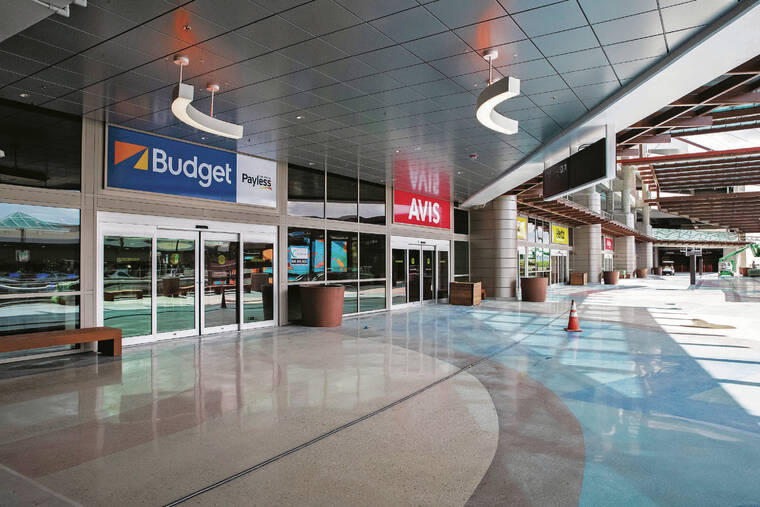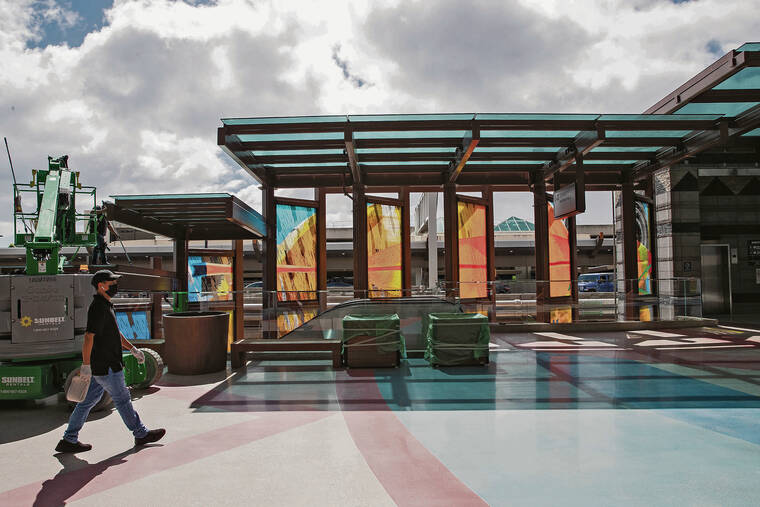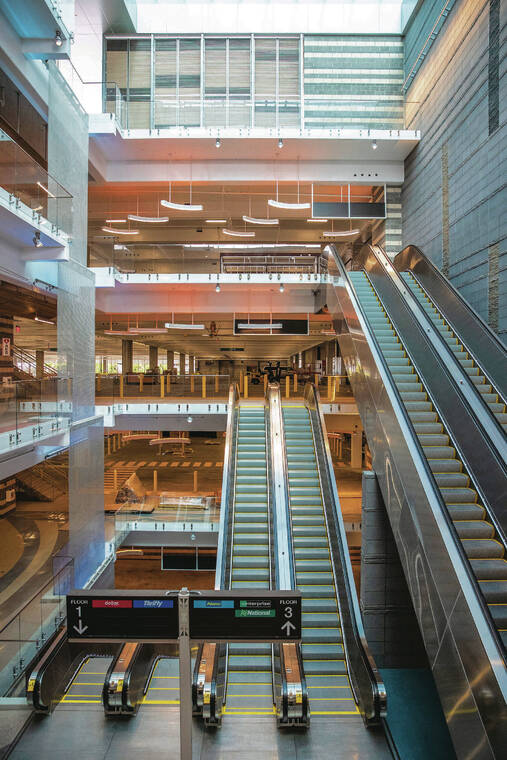A $377 million Honolulu Consolidated Rental Car Facility officially opens for business Wednesday to mark the completion of all major Honolulu projects in a $2.6 billion statewide airport modernization plan.
Gov. David Ige and officials from the state Department of Transportation will dedicate the CONRAC at Daniel K. Inouye International Airport on Tuesday morning.
DOT Airports Division Deputy Director Ross Higashi told the Honolulu Star-Advertiser on Saturday that the Honolulu CONRAC is the biggest single-project effort that DOT has completed this calendar year.
“It’s just bigger and better,” Higashi said of the project, which will allow rental car brands to locate their operations within the same centrally located, covered airport structure, which is directly across from the airline terminals.
He said it opens with nine rental car brands: Enterprise, Alamo, National, Hertz, Avis, Budget, Dollar, Thrifty and Sixt, which opened a Honolulu branch in 2020.
Higashi said the centralized five-story project makes it easier for car rental companies to control and maintain their inventory. In addition to offering places to store and rent cars, he said the facility has space to fuel cars and to wash and repair them.
Higashi said the new facility will improve the visitor arrival experience, as well as reduce airport traffic by eliminating the need for rental car companies to run pickup shuttles on a constant loop. Higashi said many customers will be able to walk to the Honolulu CONRAC. A consolidated busing system will transport the remaining customers to and from the facility, thus substantially reducing the number of shuttle buses on airport and terminal roadways, he said.
“It’s definitely quicker and prevents confusion,” he said. “It also reduces the carbon footprint.”
Higashi said planning for the Honolulu CONRAC began in 2012 when the site was selected, with construction starting in 2016. Project engineers said construction had to be completed in phases because the CONRAC is on the site of previous rental car facilities. These rental car companies had to temporarily relocate their rental car operations to the overseas parking garage, eliminating about 1,000 public parking spaces, which are expected to be restored in April.
The Honolulu CONRAC will offer the same services as the Maui CONRAC, which opened in May 2019 and has received “overwhelmingly positive” customer feedback, according to Higashi. The Honolulu facility, which has space for 4,500 rental cars, is just slightly smaller in scope than the Maui CONRAC, which can hold approximately 4,600 rental cars.
The project comes on the heels of the October opening of the permanent federal inspection service facility at Ellison Onizuka Kona International Airport at Keahole. The 32,700-square-foot facility, which cost approximately $58.7 million, allows the Kona airport to serve as a second international entry point.
It also follows the August opening of a $270 million Mauka Concourse at Daniel K. Inouye International Airport, which marked the first gate expansion in nearly three decades.
Higashi said the 230,000- square-foot Mauka Concourse can accommodate up to 11 aircraft at any given time, alleviating the gate pressure that Daniel K. Inouye International Airport faces each day between 10 a.m. and 3 p.m. The gate expansion also added six new Transportation Security Administration lanes. That brought the number of checkpoint lanes in Terminal 1 to 10, allowing passengers to get through entry lines more quickly and in less crowded conditions.
Once tourism normalizes, the Mauka Concourse and the Honolulu CONRAC could help the state’s largest airport accommodate more flights and passengers as well as provide an option for rental car companies to expand capacity.
Hawaii DOT Director Jade Butay said in a statement that the permanent inspection facility in Kona also ensures the resilience of the state’s air routes.
“Having two international entry points into the state is important in case an emergency impacts our ability to receive flights at an airport,” Butay said.
Still to come under the current airport modernization plan is expansion of the hold rooms at the Kahului Airport gates. The roughly $47 million project, which is slated for completion in 2024, will increase hold-room space by 22,000 square feet, to 37,000 square feet.
Higashi said state general funds and taxes were not used for the airport modernization, which has been paid for from airline rents and landing fees, federal grants, passenger facility charges and airport revenue bonds that will be paid back with airport user fees.
He said the Honolulu CONRAC was constructed through a state customer facility charge, $4.50 applied daily to customers who rent a car.
While it is not part of current statewide airport modernization projects, the DOT Airports master planning effort for the Lihue airport also includes various CONRAC concepts.
DOT spokesman Jai Cunningham said further improvements could be funded through President Joe Biden’s $1 trillion bipartisan infrastructure law, which will provide Hawaii airports with some $246 million over the next five years.
While improvements at state airports in Honolulu and elsewhere allow for tourism expansion, the current focus is more likely to center on greater efficiency.
Not all Hawaii residents are convinced that the benefits of more tourism will outweigh the costs. Anti-tourism pushback has come recently from those who fear that Hawaii has more visitors than it can handle, especially during the pandemic.
Hawaii Tourism Authority’s recently completed Oahu Destination Management Action Plan says that the agency will work to “decrease the total number of visitors to Oahu.”
“Decreasing the total number of visitors to Oahu to a manageable level by controlling the number of visitor accommodations and exploring changes to land use, zoning and airport policies” is the top anchor action in the Oahu DMAP.
Managing visitors’ use of cars is another top priority in the Oahu DMAP, which focuses on key actions that the community, visitor industry and other sectors deem necessary over a three-year period.
OPEN FOR BUSINESS
Daniel K. Inouye International Airport’s Honolulu Consolidated Rental Car Facility:
>> Footprint: 370,000 square feet
>> Cost: $377 million
>> Completion: Opening Wednesday, and more public parking to be restored in April
Source: DOT






